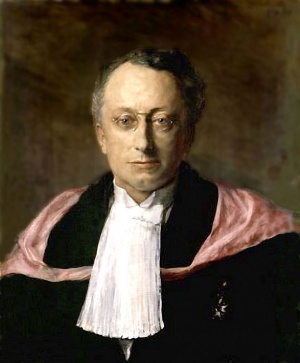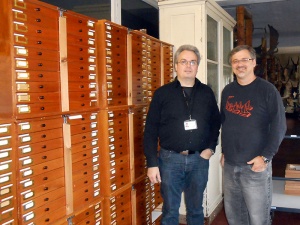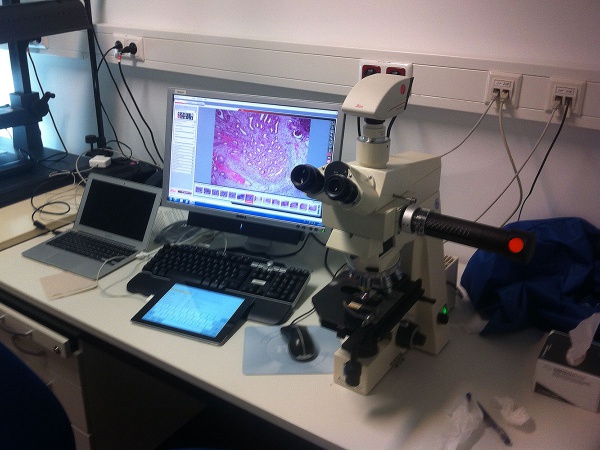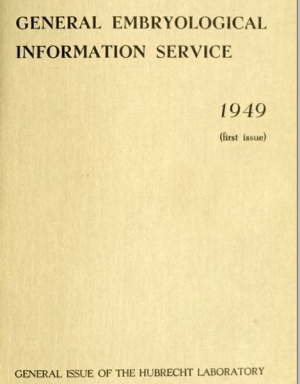Hubrecht Collection
| Embryology - 28 Apr 2024 |
|---|
| Google Translate - select your language from the list shown below (this will open a new external page) |
|
العربية | català | 中文 | 中國傳統的 | français | Deutsche | עִברִית | हिंदी | bahasa Indonesia | italiano | 日本語 | 한국어 | မြန်မာ | Pilipino | Polskie | português | ਪੰਜਾਬੀ ਦੇ | Română | русский | Español | Swahili | Svensk | ไทย | Türkçe | اردو | ייִדיש | Tiếng Việt These external translations are automated and may not be accurate. (More? About Translations) |
Introduction

(Netherlands Institute for Developmental Biology in Utrecht, Hubrecht Laboratory)
In 2004 was relocated to the Museum fur Naturkunde, Berlin and incorporates the Hill collection (James Peter Hill 1873-1954).
- The Hubrecht Laboratory[1] was founded in 1916 from Ambrosius Arnold Willem Hubrecht (1853-1915) personal collection.[2]
- The collection is for comparative embryology of vertebrates and includes a large number of animal embryos (also an associated historical library).
- 600 species of chordate, in 175 families and 10 classes.
- 2,000 wet specimens.
- histological sections (A. Dohrn - Pisces, Amphibia, Reptilia; L. Bolk - Vertebrates; and W. Kückenthal - Cetacea)
- material blocked out in paraffin but not sectioned.
This collection is located in the Embryological Collection at the Museum für Naturkunde.
Stage 20 Embryo
Image source: The images from the Hubrecht Collection/Hill Collection/Bolk Collection (all part of the Embryological Collection) are reproduced with the permission of the Museum für Naturkunde, Leibniz Institute for Research on Evolution and Biodiversity. Images are for educational purposes only and must not be reproduced electronically or in writing without permission from the Museum für Naturkunde Berlin.
Hubrecht photomicrography setup
Historic Resources
Central Embryological Library
In the general circular of the Hubrecht Laboratory in 1948, we mentioned the project of a Central Embryological Library, which will be at the disposal of every embryologist over the whole world.
The collection of this central library will consist in the first place of a complete collection of reprints of embryological work, and in the second place of a collection of special handbooks and embryological periodicals.
The significance of such a central library will become clear when we give a short survey of its general modes of use.
- a. Every embryologist can ask for information about literature on special subjects or of certain authors, about newly published literature, etc., etc.
- b. Every embryologist can ask for special papers which are not available in his own country. The Hubrecht Laboratory will lend them — under certain general conditions —to every embryologist.
- c. Every embryologist can personally consult the Library of the Hubrecht Laboratory at all times.
- d. The central library will be at the disposal of every embryologist, who is carrying out scientific work at the Hubrecht Laboratory.
Text from General Embryological Information Service (1949)
General Embryological Information Service
Published annually by the Hubrecht Laboratory, 1949-1981
Source: http://hpsrepository.asu.edu/handle/10776/4210
The General Embryological Information Service (GEIS) was an annual report published by the Hubrecht Laboratory in Utrecht, The Netherlands from 1949 to 1981 that disseminated contemporary research information to developmental biologists. The purpose of the annual report was to catalog the names, addresses, and associated research of every developmental biologist in the world. Pieter Nieuwkoop edited each issue from 1949 until 1964, when Job Faber began assisting Nieuwkoop. Bert Z. Salomé joined the editing team in 1968 before Nieuwkoop ceased editing duties in 1971. Faber and Salomé remained the editors from 1971 until the periodical's final year of circulation in 1981. The Hubrecht Laboratory, a national laboratory created to house a large collection of comparative embryological materials and loan them to interested researchers, sponsored the publication after World War II to facilitate international collaboration and prevent unnecessary duplication of work. The catalog of researchers and the scientific topics grew in number and variety as the field of developmental biology changed during the publication's thirty-two year history.
Ambrosius Arnold Willem Hubrecht created the Institut International d'Embryologie (International Institute of Embryology) in Utrecht, The Netherlands, in 1911. Hubrecht had championed Charles Darwin's work in the late nineteenth century, and Hubrecht collected specimens of embryos from around the world to demonstrate evolutionary connections between animals. Near the end of his life Hubrecht tried to establish an international community of embryologists through the Institut, but World War I disrupted his visions. In 1916, the year after Hubrecht's death, the Dutch scientific community made his collection available to scientists across the world, and thereby furthered Hubrecht's mission of developing an international research network. The Dutch Royal Academy refounded the Institut as the Hubrecht Laboratory to honor its creator.
The Hubrecht Laboratory realized Hubrecht's goal to create an international institute, and for the first thirty years of its existence, director Daniel De Lange loaned out the institute's collections of comparative embryological specimens to interested researchers. In 1947 Chris P. Raven, professor at the University of Utrecht and the newly named director of the Hubrecht Laboratory, developed a new service to help support international research in embryology. He created the GEIS, which he modeled after the Drosophila Information Service (DIS), an annual report created by Calvin Bridges and Milislav Demerec in the US in 1934. The DIS catalogued research on Drosophila melanogaster, recording all scientists and institutions involved with these fruit flies. The GEIS aimed to record the same information for the entire field of embryology. Financially, GEIS relied on subscribers and contributions from institutions such as the International Union of Biological Sciences, the Organization of Pure Scientific Research in the Netherlands, and later the General Embryological Information Service Foundation.
Before 1947, the Hubrecht Laboratory focused on establishing international collaboration in the field of embryology. However, when Raven took over, he and his newly appointed deputy director, Nieuwkoop, expanded the services of the laboratory beyond providing access to embryology collections. In particular, experimental research had become a prominent part of embryology, but the laboratory's collections were more appropriate for descriptive and comparative purposes. To involve the organization in experimental science without conducting research, Raven and Nieuwkoop decided that the Laboratory could act as an information hub, collecting and disseminating information about experiments. This information would include who was conducting embryology research, the focus of their research, and where it was occurring. At that time, besides talking to and writing each other, there were few means for researchers to find out what others were researching across the globe. Instead, they had to wait until other scientists published their results to learn of new developments, a method of information transfer that many felt caused too much unnecessary overlap between experiments. Furthermore, Europeans in the late 1940s were rebuilding their nations in the aftermath of World War II. Many scientific communities had fragmented during the war as scientists fled occupied territories and as allied countries funded war-related projects rather than basic biological research. Raven and Nieuwkoop envisioned a catalog that would help rebuild the international embryology community through the sharing of information, and that would help create new collaborations between individuals.
Beginning in 1948, the GEIS editors sent out an annual survey to every known embryologist and related scientific institution. The form requested the names and addresses of the embryologists, information on their home institutions, and the details of their current research projects, not including recently published research. The GEIS editors compiled the returned information and created a catalog of embryology, which institutions and individual researchers paid yearly dues to receive. In 1949, the first year of the GEIS publication, Nieuwkoop included nearly 700 names and addresses of embryologists from 245 institutions in twenty-eight countries. Nieuwkoop continued to expand the GEIS throughout his time as director of the Laboratory, from 1953 until 1980. By the time Nieuwkoop retired in 1980, the GEIS boasted 3,400 names from 1,200 institutions in fifty different countries.
For the first two decades of its existence, each full length GEIS issue consisted of about nine sections. Each issue began with an introduction by the editor, which contained an explanation of any slight changes in organization and an update on any relevant news concerning the publication. A number of directories followed. The first was an alphabetical list of embryologists' names, with associated addresses and research. The next directory was organized geographically and by institution. For instance, Viktor Hamburger, who studied neural development, was listed under United States – Missouri – Washington University, as were his colleagues Thomas Hall, Florence Moog, Rita Levi-Montalcini, and Eleanor Wenger. Organizing researchers by geographical location made it possible to see where concentrations of embryologists could be found throughout the world.
The catalog of current research subjects was the third and the largest directory of the report. In this section, researchers were organized according to topic, as described by each researcher. For instance, Viktor Hamburger's work in 1949 on the "Control of proliferation and differentiation of the nervous system" was organized under Experimental Developmental Morphology – Development of Organ-systems – Nervous system, ganglia, nerves and enveloping membranes – Central Nervous System. Alongside the subject was a code that identified the type of organism used in the research, as listed in the code legend. In this case, Hamburger worked with chickens (Gallus gallus), which were coded using an L, meaning aves, or birds. Starting with the 1965 volume, the subject list was reorganized into an alphabetical index of topics, and information on the organisms used was reduced.
Overall, the subject directory allowed subscribers to see who was working on closely related topics. The editors of the GEIS printed this type of information to facilitate new collaborations and to deter needless overlap in research. To keep the service as useful as possible, the editors constantly reminded subscribers to report their current projects, not recent publications, as up-to-date bibliographies were available through other channels. The GEIS editors found that scientists' work did not change dramatically from year to year and beginning in 1953, the editors published the subject directory on a biennial basis, with a supplement published in off years. In 1973 the editors changed the organization to reflect the growing number of researchers listed. They released one issue per year, and two issues comprised a volume. The first issue reported data on European researchers, and the second issue reported data on researchers outside of Europe.
The later sections of the GEIS were generally short communications, and the first of these sections discussed new technical methods. The next section, called "Supply and Demand," included information from researchers looking to buy, trade, or sell research subjects. Communications from the Hubrecht Laboratory comprised an additional section, where the editors discussed lab services offered, including a reprint library and the catalog of slides and specimens, all of which were available to subscribers. The GEIS also often included an announcements section that related news from the field, such as communications from relevant societies like the Embryological Section of the International Union of Biological Sciences. The final section of the GEIS reviewed relevant literature for teaching, including monographs and new journals. All sections aside from the subject directory and the new methods section continued to be produced annually, but appeared as short supplementary sections with updates of any changes during years when the complete GEIS was not published. After the reorganization of volume division in 1973, each annual issue still contained an introduction; three directories of researchers listed by name, by institute, then by subject; communications from organizations including the Hubrecht laboratory; and book notices and reviews.
The GEIS provides a record of how embryology changed between 1947 and 1981. The discovery of DNA in 1953 and the subsequent growth of molecular biology and biomedicine dramatically changed many biological fields, including embryology. The increase in numbers of researchers and active research locations noted in the GEIS provides a picture of the changing geographies of the field during this time. Similarly, the changes in the research directory reflect the evolution of the field of embryology. The GEIS recorded that fewer researchers used amphibians and arthropods as traditional focuses of experimental embryology that relied on these animal models became less popular. In contrast, the number of researchers working on development and pathology increased during the 1950s and 1960s as agencies such as the US National Institutes of Health funded research in those fields.
By the early 1980s, when the Hubrecht Laboratory stopped the publication of the GEIS, there was an international community of developmental biologists, and biologists studied embryology in scientific institutions around the world. As researchers communicated with each other in new ways and as the number of scientific journals grew, they decreasingly used the GEIS, a trend that reflected the rapidly diminishing subscriptions in the last few years of the GEIS. The Hubrecht Laboratory ceased publishing the report in 1981 because there were too few subscribers to support the service.
General Embryological Information Service 1 (1949)
Sources
Dietrich MR & Tambasco BH. (2007). Beyond the boss and the boys: women and the division of labor in Drosophila genetics in the United States, 1934-1970. J Hist Biol , 40, 509-28. PMID: 18380055
Faasse P, Faber J & Narraway J. (1999). A brief history of the Hubrecht Laboratory. Int. J. Dev. Biol. , 43, 583-90. PMID: 10668967
General Embryological Information Service reports, 1949–1981. Eds. Peter Nieuwkoop, Job Faber, Bert Z. Salomé. Utrecht: Hubrecht Laboratory. http://www.biodiversitylibrary.org/item/25962 (Accessed October 31, 2012.)
References
External Links
External Links Notice - The dynamic nature of the internet may mean that some of these listed links may no longer function. If the link no longer works search the web with the link text or name. Links to any external commercial sites are provided for information purposes only and should never be considered an endorsement. UNSW Embryology is provided as an educational resource with no clinical information or commercial affiliation.
- Museum für Naturkunde, Leibniz Institute for Research on Evolution and Biodiversity.
- Internet Achieve 1949
- Search internet archive Hubrecht-Laboratorium (Embryologisch Instituut)
| Embryologists: William Hunter | Wilhelm Roux | Caspar Wolff | Wilhelm His | Oscar Hertwig | Julius Kollmann | Hans Spemann | Francis Balfour | Charles Minot | Ambrosius Hubrecht | Charles Bardeen | Franz Keibel | Franklin Mall | Florence Sabin | George Streeter | George Corner | James Hill | Jan Florian | Thomas Bryce | Thomas Morgan | Ernest Frazer | Francisco Orts-Llorca | José Doménech Mateu | Frederic Lewis | Arthur Meyer | Robert Meyer | Erich Blechschmidt | Klaus Hinrichsen | Hideo Nishimura | Arthur Hertig | John Rock | Viktor Hamburger | Mary Lyon | Nicole Le Douarin | Robert Winston | Fabiola Müller | Ronan O'Rahilly | Robert Edwards | John Gurdon | Shinya Yamanaka | Embryology History | Category:People | ||
|
Glossary Links
- Glossary: A | B | C | D | E | F | G | H | I | J | K | L | M | N | O | P | Q | R | S | T | U | V | W | X | Y | Z | Numbers | Symbols | Term Link
Cite this page: Hill, M.A. (2024, April 28) Embryology Hubrecht Collection. Retrieved from https://embryology.med.unsw.edu.au/embryology/index.php/Hubrecht_Collection
- © Dr Mark Hill 2024, UNSW Embryology ISBN: 978 0 7334 2609 4 - UNSW CRICOS Provider Code No. 00098G






